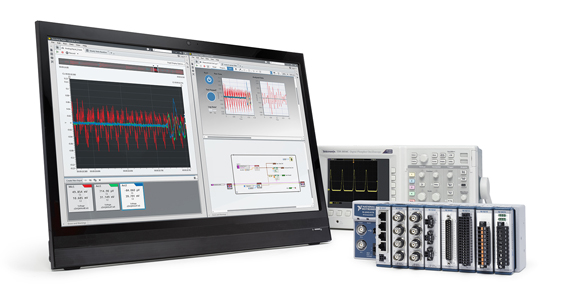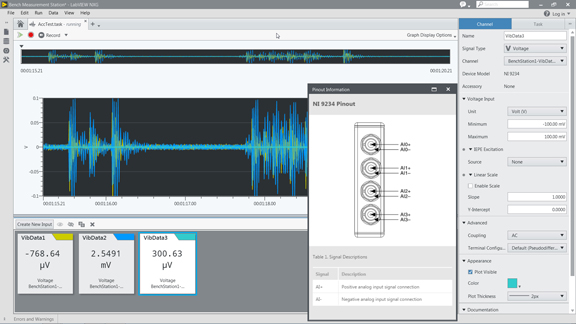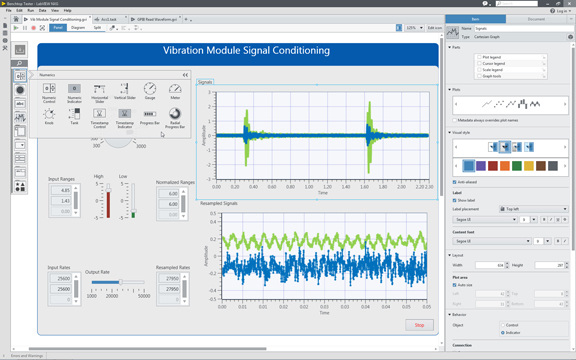
NI introduces LabVIEW NXG, a new version of LabVIEW, at NI Week conference (image courtesy of NI).
Latest News
May 26, 2017
Jeff Kodosky, NI cofounder and business and technology fellow, is better known as “the father of LabVIEW.” This week, at the opening of NI Week 2017 in Austin, Texas, he outlined the new direction his brainchild is about to take.
“I occasionally get asked to describe what LabVIEW is, both by people who have never heard of it and by experienced users,” he reflected. “I still struggle to find an accurate and concise description that would make everyone say, Ah, I get it! Describing LabVIEW’s interlocking features of virtual instruments, panels, diagrams and so on quickly gets into a swirl of details that miss the big picture. But even in the big picture, it’s difficult to describe what LabVIEW is without getting into what it was. And what it is, doesn’t do justice to what is becoming.”
With the launch of LabVIEW NXG, LabVIEW is about to become easier to adopt and master, especially for new, casual users.
 NI introduces LabVIEW NXG, a new version of LabVIEW, at NI Week 2017 conference (image courtesy of NI).
NI introduces LabVIEW NXG, a new version of LabVIEW, at NI Week 2017 conference (image courtesy of NI).What is LabVIEW?
Originally, LabVIEW was meant to be a graphical user interface (GUI) to control instruments, inspired by the early Macintosh’s GUI-driven OS. It was once marketed as “the non-programming way to automate measurements,” recalled Kodosky. Though initially intended for test engineers, LabVIEW quickly found a much wider audience, which now encompasses scientists, chemists, physicists, researchers, and even students in the FIRST Robotics Competition.
According to Kodosky, LabVIEW is now used for “controlling proton beams in cancer therapy, monitoring track circuits in the London underground, shrinking semiconductor test times, advancing 5G research,” and more.
The richness of LabVIEW, now considered a leading graphical systems design software, is a reflection of the feature growth over the past 30 years. As a result “LabVIEW has become somewhat daunting to casual users looking to make simple measurements,” Kodosky observed.
LabVIEW NXG is the outcome of NI’s efforts to make its flagship software much more approachable.
The Way Forward
Both versions share some core technology components, such as the run-time engine and the code compiler. But tools for deploying the software with certain hardware like LabVIEW Real-Time Module, LabVIEW FPGA Module, and CompaqRIO platform are not available in LabVIEW NXG. On the other hand, LabVIEW NXG can automatically discover third-party hardware and install the appropriate drivers—something LabVIEW 2017 doesn’t do. (For a side-by-side feature comparison, look at NI’s chart here.)
In the long run, NI plans to consolidate the two versions. But version 1.0 of LabVIEW NXG will strike many as a lightweight version of LabVIEW standard.
“NXG is a lightweight version plus some capabilities that LabVIEW standard currently doesn’t do well,” pointed out Jeff Phillips, NI’s section manager for platform software. “But in a year or two, as we move forward, NXG won’t be a lightweight version anymore. By then, NXG will become functionally just as capable as the standard version, but lightweight in its installed footprint, memory usage, and speed.”
NXG comes with a migration utility to convert LabVIEW 2017 projects into labVIEW NXG counterparts. A similar utility doesn’t exist in LabVIEW 2017. The one-way data flow facilitated by NI clearly indicates LabVIEW NXG is the company’s vision of the future. So when the two versions finally merges, NXG’s personalities and characteristics will be at the forefront.
 The streamlined modern UI in LabVIEW NXG is expected to appeal to new users (image courtesy of NI).
The streamlined modern UI in LabVIEW NXG is expected to appeal to new users (image courtesy of NI). Vibration signal conditioning in LabVIEW NXG (image courtesy of NI).
Vibration signal conditioning in LabVIEW NXG (image courtesy of NI).Easier Way to Publish Web VIs
LabVIEW gives users a way to publish web VIs, or web clients that can be used from standard browsers. The feature is useful if you want to give engineers a way to remotely run and validate certain tests from a browser, without having to directly access the machine where LabVIEW is installed.
The VI publishing function in LabVIEW NXG “works way better,” said Phillips. “We took all the components of LabVIEW blog diagrams—the logic of it—and built a compiler that turns it into JAVA scripts instead of machine codes,” he pointed out.
Attracting new users with LabVIEW NXG and placating existing users with LabVIEW 2017 is a delicate balance. For now, NI has decided to include LabVIEW NXG in the purchase price of LabVIEW 2017. In other words, you get both LabVIEW NXG and LabVIEW 2017 when you purchase the latter.
This pricing strategy works well to entice current LabVIEW users to give NXG a spin at no additional cost. But new users attracted to NXG’s modern interface may have second thoughts about paying the price of full-fledged LabVIEW 2017 to get access to LabVIEW NXG.
“If we see that the market demands two different pricing, we’ll respond accordingly,” said Phillips.
Subscribe to our FREE magazine, FREE email newsletters or both!
Latest News
About the Author
Kenneth Wong is Digital Engineering’s resident blogger and senior editor. Email him at [email protected] or share your thoughts on this article at digitaleng.news/facebook.
Follow DERelated Topics






